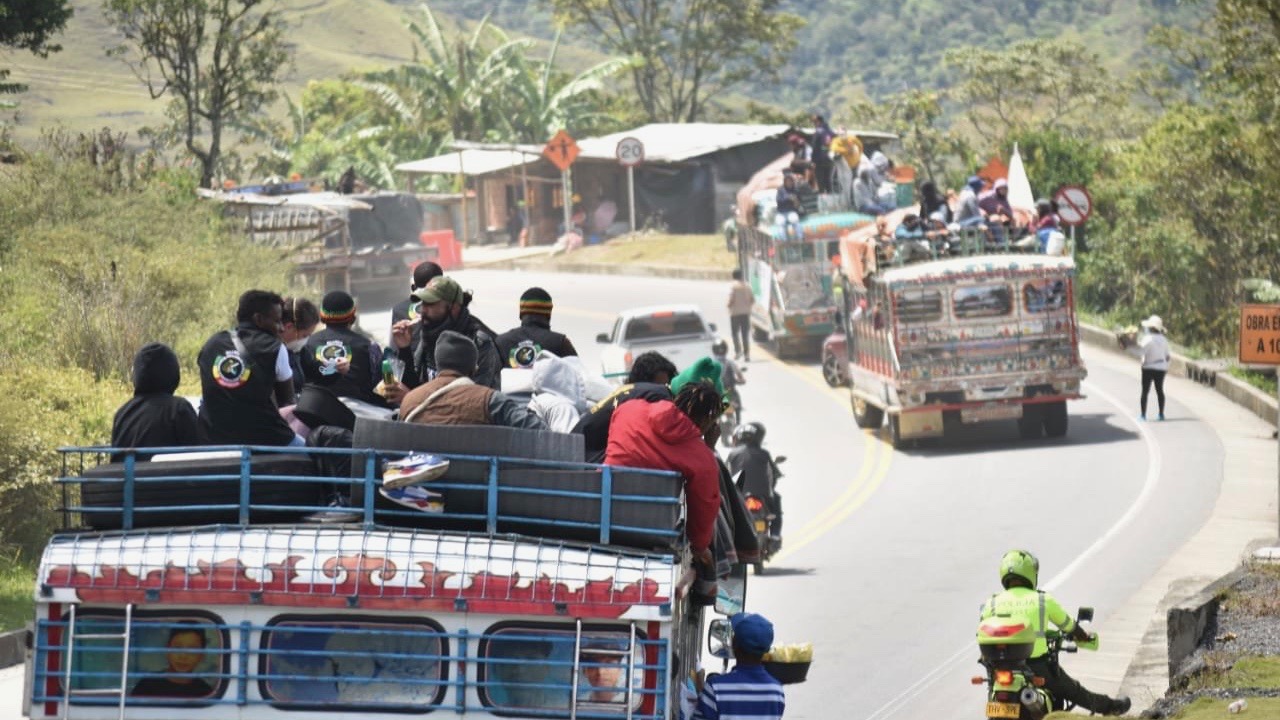Mobilizations to demand an end to escalating violence in Colombia against social movements and political activists have intensified in recent days. Social movements have converged in the Cauca department as part of a Humanitarian Caravan, while ex-combatants of the Revolutionary Armed Forces of Colombia (FARC), today part of the Common Alternative Revolutionary Force party, have been marching in the Pilgrimage for Life and Peace. Organizations are demanding that the government take measures to stop the increase in violence and protect the life and integrity of citizens.
Humanitarian Caravan for Life and Defense of Territory in the Cañón del Micay
Over 500 participants from more than 30 Afro-descendant, Indigenous, human rights, peasant and social organizations from the Cauca department, on October 29, began a Humanitarian Caravan for Life and Defense of Territory in the Cañón del Micay, an area made up of the municipalities of Algeria, El Tambo and López del Micay.
The objective of the caravan is to draw the national government’s attention to the humanitarian crisis faced by these communities in this territory and to accompany and show solidarity with the people who suffer the increase in socio-political violence.
The participants of the caravan, who left from the city of Popayán, received a warm welcome in all the towns and villages they passed through in these three municipalities in the past four days. Various different political, cultural and artistic events were organized in the places the caravan made a stop to call on the people to continue the struggle for peace with hope.
🚌🏞️ Al son de los tambores, los aplausos y los cantos continúa la #CaravanaHumanitariaAlMicay "Un canto por la vida y la paz del territorio" @renacientes pic.twitter.com/7Qop2OaZuY
— Coordinador Nacional Agrario | CNA-Colombia (@CNA_Colombia) October 31, 2020
Today, on November 2, the caravan will conclude and the member organizations will announce their decision on whether the caravan will advance to the capital Bogotá, to meet the president and present its demands.
The caravan was organized jointly by the Black Communities Process (PCN), the Regional Indigenous Council of Cauca (CRIC), the National Agrarian Coordinator (CNA) and the People’s Congress (CdP).
“There is a coexistence between the military forces and the various armed groups. This has exacerbated the violence, dispossession and expulsion of many communities that have suffered the murder of their leaders and members,” denounced Marlyen Serna, peasant leader from Cauca and spokesperson for the CDP, highlighting the reason for the grave situations faced by the communities living in the department.
“Generating a conflict in Cauca is intended to establish a military force with full legitimacy. Thus, Ivan Duque guarantees extractivism and drug trafficking business that benefits the political elite in power,” denounced the CDP in a tweet, explaining the reason why the government is not fighting paramilitarism.
Pilgrimage for Life and Peace
Meanwhile, hundreds of ex-combatants of the FARC, on October 21, began a Pilgrimage for Life and Peace from the Mesetas town in the Meta department to the capital city Bogotá to demand that the national government comply with the peace agreements signed between the former government and the FARC in Havana, Cuba, in 2016.
The former guerilla fighters, along with several human rights defenders and social activists who joined them in the course of their journey, reached Bogotá yesterday, on November 1. In the capital, over 2,000 ex-combatants of the FARC and members of various social and political organizations held a massive peaceful demonstration at the Plaza Bolivar, demanding cessation of the murders of the former combatants and respect for their right to life.
Decían que no iba a venir nadie pero acá estamos y aún hay compañerxs en camino.
¡No queremos que se nos siga asesinando por querer la paz!#PorLaVidaYPorLaPaz pic.twitter.com/rBxzdw8Egb— FARC #PorLaVidaYPorLaPaz (@PartidoFARC) November 1, 2020
The pilgrimage was organized by members of the Common Alternative Revolutionary Forces (FARC) political party, which emerged after their disarmament and demobilization of the guerilla group as a part of the peace agreements. The brutal assassination of ex-guerrillero Juan de Jesus Monroy and his personal bodyguard Luis Alexander Largo, on October 16 in Mesetas, was the impetus for the peace signatories to embark on the march.
Since the signing of the peace agreements, 236 former FARC combatants have been killed. The FARC party has repeatedly condemned Duque’s administration for its lack of will to comply with peace agreements and implement measures to stop violence against them.
Nevertheless, the FARC party stated that former combatants will continue to comply with commitments to uphold peace in the country. “We will continue working, relentlessly, with love, hope and dignity throughout the national territory, for the forgotten Colombia, for the humble people. We will continue with the most beautiful battle we have fought: the battle for the peace of the nation,” the party wrote in a tweet.
Violence in Colombia
Colombia has seen a major increase in political violence and systematic extermination since Iván Duque took office in 2018. This has been accompanied by a campaign of stigmatization and criminalization of those who take part in social protests which has also been denounced by numerous social organizations.
According to the Institute of Development and Peace Studies (INDEPAZ), since August 7, 2018, the day Duque assumed the presidency, more than 600 social activists and more than 150 former FARC combatants have been assassinated.
Likewise, according to the data collected by the INDEPAZ, so far in 2020, 248 environmentalists, human rights defenders, Indigenous, peasant and social leaders, and 51 ex-combatants of the FARC, were killed. Additionally, the organization reported that 278 people were killed in 70 massacres registered in the country between January 1 and October 31, 2020. The department of Cauca is the second most affected region with 10 massacres in ten months, after Antioquia with 15 massacres.





